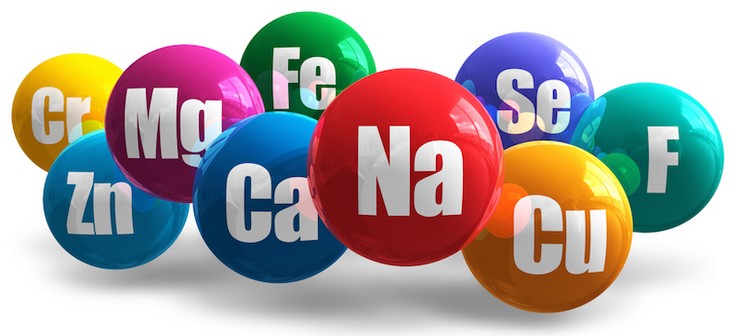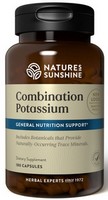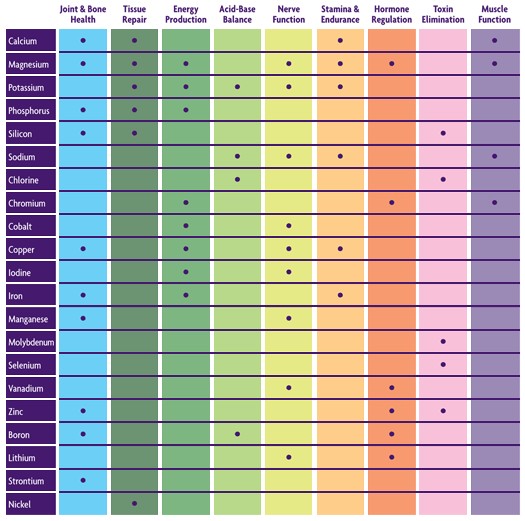
Your 2-3 pounds of calcium resides mostly in the bones and teeth. It also
is important for healthy nerve impulses, and is a natural tranquilizer. It helps
prevent cadmium and lead poisoning, as well as absorbing strontium 90, a
radioactive material from nuclear explosions. It is needed for a strong
immune system, helps the body lower cholesterol and aids in preventing
colon cancer. It is also one of the elements needed to lower blood pressure.
Calcium is commonly found in nature and in our food. So why are we
often deficient?
 A high fat diet or low hydrochloric acid (HCl) in the
stomach prevents us from assimilating it. Low amounts of HCl is almost
universal in older people, hence they wind up calcium deficient. HCl is also
needed to absorb iron to build up the blood. (For this reason, persons over
50 should consider taking PDA to increase general mineral uptake.)
A high fat diet or low hydrochloric acid (HCl) in the
stomach prevents us from assimilating it. Low amounts of HCl is almost
universal in older people, hence they wind up calcium deficient. HCl is also
needed to absorb iron to build up the blood. (For this reason, persons over
50 should consider taking PDA to increase general mineral uptake.)
Another reason people are low in calcium is that by eating too much meat
or other high-phosphorus foods, the phosphorus drives out what could have
been a normal calcium intake. You will notice that when you talk about
nutrition, you are talking about balance. If another element is too prevalent,
that may be your problem, and not what “appears” to be a lack of calcium
in your diet at all!
The same reasoning should go into solving the osteoporosis problem so
common in women after menopause (and men can have the problem too!).
We need to understand that bones are also made of protein, and perhaps
through poor digestion and diet, the protein to make the little sacks holding
calcium and other minerals constituting bone is a major cause of bone
weakness, not a lack of calcium! You see the danger of having just a little
knowledge, but also the dividends of doing a little detective work on your
own!
 Along with eating your green, leafy veggies, citrus fruits, beans, grains
and nuts, extra supplementation may be needed. Vitamin Calcium w/
Magnesium is important because calcium needs vitamin D to be absorbed
into the body (see also Calcium + D3).
In addition, the mineral magnesium helps direct calcium to perform
correctly in the body. Sometimes what looks like too little calcium is plenty
of calcium with not enough magnesium to activate the calcium properly! A
deficiency of trace elements like copper, boron and silica may also prevent
calcium from doing its job. We are right back to the principles of balance and
teamwork.
Along with eating your green, leafy veggies, citrus fruits, beans, grains
and nuts, extra supplementation may be needed. Vitamin Calcium w/
Magnesium is important because calcium needs vitamin D to be absorbed
into the body (see also Calcium + D3).
In addition, the mineral magnesium helps direct calcium to perform
correctly in the body. Sometimes what looks like too little calcium is plenty
of calcium with not enough magnesium to activate the calcium properly! A
deficiency of trace elements like copper, boron and silica may also prevent
calcium from doing its job. We are right back to the principles of balance and
teamwork.
Food sources: goat’s milk, green vegetables, kale, seeds, nuts, whole
grains, sesame seeds, bonemeal.
Herb sources: valerian root, white oak bark, pau d’arco bark, kelp,
comfrey leaves, capsicum, red raspberry, horsetail, alfalfa.
There is
evidence that the mineral silicon can be transformed by the body into
calcium when needed. This fascinating theory is based on the eating habits
of animals, who end up with more calcium than they eat or drink! So where
is it coming from?

Phosphorus
Calcium and phosphorus work together, but deficiencies in phosphorus
are uncommon. However, chronic use of antacids can result in a deficiency
or else kidney problems. (In some cases the kidneys can retain too much
phosphorus, as well as magnesium, and then either can cause a loss of
calcium.) Aluminum from antiperspirants may also impair phosphorus
metabolism in the body. It is the second most abundant mineral in man and
helps control energy transfer within cells.
Phosphorus also works to neutralize excess blood acidity and along with
B vitamins is used by the liver to create its own lecithin, which increases
mental powers and helps to keep the arteries clear of fats.
Deficiency symptoms include nervousness, insomnia, poor hair growth,
numbness of skin, shallow breathing, loss of appetite, fatigue and depression.
But remember that other deficiencies cause some of these same
symptoms. Be a good sleuth before deciding what is causing your particular
problem.
Food sources: seafood, eggs, dairy products, vegetables, whole grains,
nuts, seeds, meat.
Herb sources: pumpkin seeds, peppermint leaves, fennel, hops, chickweed,
burdock, parsley, garlic, dandelion.
Potassium
 Don’t get phosphorus mixed up with potassium. You could think of
phosphorus as a grenade exploding body energy whereas potassium is a “pot” in the liver helping to balance the body, prevent constipation, relieve
pain, and keep tissues elastic. Potassium is also one of the lightest metals known, so soft it can be cut
with a knife. You only need about a third of one percent of it as your total
body. The heart needs it to keep beating, as do all muscles for them to
function. Potassium is found most abundantly inside the cells and helps
keep sodium at bay. Between the two minerals, a balance is kept that
provides energy and an electrolytic balance between the fluids in and
outside of the cell. Otherwise, the cell could not breathe properly and would
suffocate. A lack of potassium allows sodium (“salt”) to creep into the cell
and bring bloating water with it.
Don’t get phosphorus mixed up with potassium. You could think of
phosphorus as a grenade exploding body energy whereas potassium is a “pot” in the liver helping to balance the body, prevent constipation, relieve
pain, and keep tissues elastic. Potassium is also one of the lightest metals known, so soft it can be cut
with a knife. You only need about a third of one percent of it as your total
body. The heart needs it to keep beating, as do all muscles for them to
function. Potassium is found most abundantly inside the cells and helps
keep sodium at bay. Between the two minerals, a balance is kept that
provides energy and an electrolytic balance between the fluids in and
outside of the cell. Otherwise, the cell could not breathe properly and would
suffocate. A lack of potassium allows sodium (“salt”) to creep into the cell
and bring bloating water with it.
As a point of interest, cancer cells are
loaded with sodium. That makes enough potassium important to help
prevent cancer.
Symptoms of a deficiency include edema, continuous thirst, hypoglycemia,
dry skin, weakness, swollen testicles or ovaries.
Food sources: apricots, broccoli, celery, watercress, potatoes, almonds,
avocados and sunflower seeds.
Herbal sources: parsley, blessed thistle, barley grass, sage, catnip, hops,
peppermint leaves, feverfew, and scullcap.
To conveniently get a concentrated
amount in a hurry, try Potassium Combination. Each tablet contains
42 mg. of chelated potassium in a base of kelp, dulse, watercress, wild
cabbage, horseradish and horsetail herbs.
Sodium
 Here is another metal, but in a pure state it will explode upon contact with
a liquid. When combined with chlorine it forms salt. Although salt is highly
condemned because it tends to raise blood pressure and hold too much water
in the body, it is absolutely necessary for life to continue. Some people who
are suffering from chronic fatigue have recovered after increasing their
sodium intake, which the adrenals require to function properly.
Here is another metal, but in a pure state it will explode upon contact with
a liquid. When combined with chlorine it forms salt. Although salt is highly
condemned because it tends to raise blood pressure and hold too much water
in the body, it is absolutely necessary for life to continue. Some people who
are suffering from chronic fatigue have recovered after increasing their
sodium intake, which the adrenals require to function properly.
Sodium helps regulate the movement of water across cell membranes. It
also helps calcium and other minerals remain soluble in the blood so they
won’t clog the capillaries. It also helps the body absorb iron. A shortage
is uncommon in humans, but too much sweating, diarrhea or starvation can
bring on a deficiency.
There is evidence that regular table salt, as it exists at the molecular level,
is hard for the body to break apart and use properly. But in natural foods,
sodium is easily extracted.
Food sources: sea foods, beets, green, leafy vegetables (especially
celery), carrots.
Herb sources: kelp, Irish moss, rose hips, gotu kola, licorice, parsley,
chamomile, fennel, and dill.
Magnesium
 Along with potassium, here is a mineral that is important in preventing
heart attacks. Magnesium not only manages calcium, it helps manage nerve
communications everywhere in the body. Through stress, or over cooking,
we can lose great quantities of this mineral. Most of the U.S. population is
woefully short of magnesium. Taking a Chelated Magnesium Supplement with an herb base of licorice, kelp, peppermint and white willow bark can
make a noticeable difference, sometimes in a few minutes (if you are
experiencing muscle cramps). For twitching muscles, it may take longer
(include B vitamins). And as for your tough, decay-resistant tooth enamel,
thank magnesium.
Along with potassium, here is a mineral that is important in preventing
heart attacks. Magnesium not only manages calcium, it helps manage nerve
communications everywhere in the body. Through stress, or over cooking,
we can lose great quantities of this mineral. Most of the U.S. population is
woefully short of magnesium. Taking a Chelated Magnesium Supplement with an herb base of licorice, kelp, peppermint and white willow bark can
make a noticeable difference, sometimes in a few minutes (if you are
experiencing muscle cramps). For twitching muscles, it may take longer
(include B vitamins). And as for your tough, decay-resistant tooth enamel,
thank magnesium.
One fast way to lose magnesium is through stress—even noise stress will
do it. Fluoridated water, or synthetic vitamin D may block its action.
Diuretic drugs could do it, too.
Food sources: almonds, Brazil nuts, cashews, filberts, millet, peanuts,
pecans, walnuts, wheat, pumpkin seeds and brewer’s yeast.
Herb sources: oat straw, licorice, kelp, senna, peppermint, white willow
bark, devil’s claw, burdock, chickweed, and marshmallow.
Want to learn more? Read about: Trace Minerals

|